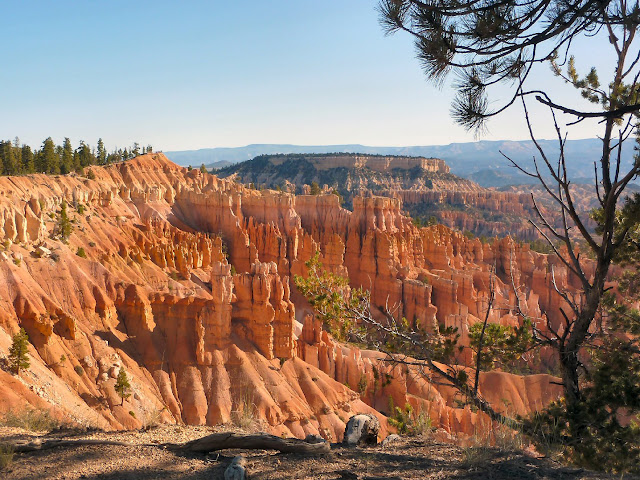Summer-Fall 2011
Bryce Canyon NPErosion on the Colorado Plateau has resulted in six National Parks and some of the most spectacular and unusual scenery in the world and I don't think there's any place stranger than Bryce Canyon.
Like the Grand Canyon, this place catches you by surprise. After we checked in at the Bryce Canyon Lodge, we noticed the trails leading into the trees and could see a clearing on the other side, so that's where we headed. There was a slight rise as we approached the rim where the earth had just fallen away. It had collapsed from erosion outward in a half-bowl shape, leaving behind a bizarre landscape of hoodoos.
We had come to Bryce Amphitheater, the best known part of the park. The tall, thin hoodoos are rock formations that occur world-wide but Bryce Canyon has the most abundant and varied collection. And the West-African concept of magic spells has a special resonance in southern Utah where Paiute tradition has Trickster Coyote responsible for turning the Legend People into these stone statues.
We were told that to really appreciate the hoodoos, you have to get down among them, so we did. The Navajo Loop Trail at Sunset Point is a switchback that leads through slot canyons and the Queen's Garden Trail at Sunrise Point leads down to a series of striking hoodoos including Queen Victoria (if you have an active imagination). Just as soon as we got below the rim, we found ourselves in a very strange and wondrous world.
 |
| Nancy and her Hoodoo Buddies |
And we did see some wildlife. A fawn and its mother were feeding outside the cabins at sunset and a herd of pronghorn grazed quietly in one of the meadows. The ravens are quite intelligent and one was especially bold. He would land on the rail in front of sightseeing tourists and try to cadge a handout. What we didn't see, however, were the wild turkeys that live in the area.
Zion NP
Although it's been 30 years, this was still a return visit for us and we made a point of visiting those parts of the park that we had missed.
Kolob Canyons
The Kolob Canyons unit is completely separate from the valley area both in distance and in geology. These canyons are formed from magnificent mountains of red sandstone that in places have eroded from rain and snow-melt to create hanging gardens and seasonal waterfalls that leave black stains down the mountain face.
 |
| Kolob Canyon Hanging Garden |
This red entry road descends from the higher areas of the park past the Checkerboard Mesa through the spectacular slickrock country toward the famous mile-long tunnel. The tunnel is an engineering marvel, cut through solid rock, and completed in 1930 with cutout windows. Today these windows give quick glimpses of the magnificent scenery.
Not very long ago, it was possible to stop at the turn-outs at each of the stone windows and take in the views, but now, with the great number of RV's and SUVs on steroids that need to drive through the center of the tunnel, the park enforces alternating one-way traffic on a fairly regular basis and no one is permitted to stop. It's definitely a loss.
Zion Canyon
Once through the tunnel, we drove several switchbacks down to the valley floor where we parked at the Visitors' Center. With the volume of visitors today, the National Park Service now tours the valley floor with shuttle buses.
Zion is often called Yosemite in color but there is only enough truth in that assertion to be annoying. The Virgin River valley through Zion has not changed much in 30 years even though flooding has removed the roadway on several occasions and our memories were both vivid and accurate. The trail to the Emerald Pools and the Riverside Walk are still the most popular hikes and, for those with more nerve than we have, the hike to the top of Angels Landing is supposed to be quite a treat.
The cabins don't seem to have changed at all. One thing that is different is the main lodge. When we stayed there, the exterior was still the modern-style facade that was part of the quick rebuild following the 1966 fire, but, in 1990, the lodge was returned to its original rustic design. Except for the dining room furnishings, which were new, the interior was just as we remembered it.
 |
| Zion Lodge |
Red Canyon
When I discovered that the Mendenhall Glacier in Juneau was a Tongass National Forest site, I thought that it was the sole exception to the rule that the National Park Service has all the great places. Red Canyon, in the Dixie National Forest, is exception number two and I will now be looking for more.
This is a beautiful site with two short tunnels carved from the red sandstone for Route 12 and a Visitors' Center sitting right in front of some of the finest specimens of hoodoos there are. It's a very dramatic and extraordinary place.
 |
| Red Canyon - Dixie National Forest |
We spent an extra night in Las Vegas looking into the very interesting real estate market there and we made it a point to check up on the health of Lake Mead. We're happy to report that the lake is up slightly. Apparently the Rockies also had an epic ski season. "Up slightly" doesn't sound very impressive until you recall that the water level has fallen every year for the last 10 years due to drought. So this is very good news.
For more pictures (and probably more hoodoos than you really care to see), click below:
Bryce Canyon-Zion Slideshow
Bryce Canyon-Zion Slideshow
